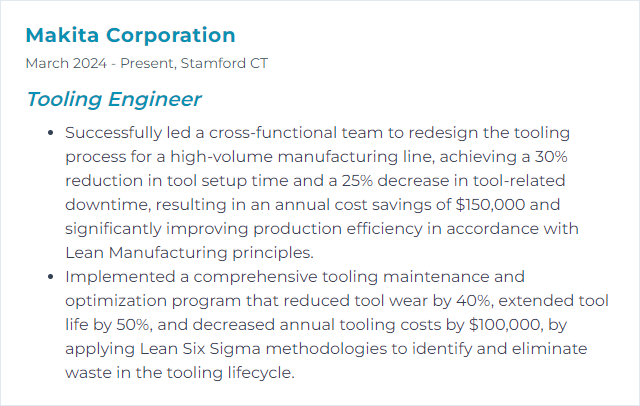Top 12 Tooling Engineer Skills to Put on Your Resume
In today's competitive job market, standing out as a tooling engineer demands a strong mix of technical depth and people-savvy judgment. Listing the right skills on your resume signals you can wrangle complex tooling work and mesh with teams under pressure.
Tooling Engineer Skills
- CAD/CAM
- SolidWorks
- AutoCAD
- CNC Programming
- Injection Molding
- 3D Printing
- Pro/ENGINEER
- Moldflow
- GD&T
- FEA
- Mastercam
- Lean Manufacturing
1. CAD/CAM
CAD/CAM stands for Computer-Aided Design and Computer-Aided Manufacturing. For a Tooling Engineer, that means designing tools, molds, and dies in software, then driving automated equipment to make them with speed, repeatability, and tight precision.
Why It's Important
CAD/CAM is the backbone of modern tooling. Precision design, fast iteration, seamless handoff to machines, fewer errors, less scrap, and a quicker path from idea to production—all in one loop.
How to Improve CAD/CAM Skills
Sharpening CAD/CAM means better models, smarter toolpaths, and tighter design-to-shop integration.
Upgrade software and hardware: Keep CAD/CAM tools current and run them on capable machines. Autodesk and SolidWorks remain industry workhorses; ensure graphics, RAM, and storage aren’t throttling you.
Use robust tool libraries: Standardize cutters, holders, and feeds/speeds. Curated, current libraries reduce guesswork and tool breakage.
Standardize your process: Templates, checklists, revision controls, and naming conventions drive consistency and reduce rework.
Keep learning: Advanced surfacing, multi-axis machining, and design-for-manufacture methods evolve fast. Schedule regular training.
Optimize toolpaths with simulation: Simulate to catch collisions, gouges, and inefficiencies. Shorter cycle times, longer tool life.
Collaborate in real time: Use cloud or PDM/PLM tools so design, programming, and the floor see the same truth.
Automate repetitive work: Macros, design tables, and scripts banish drudgery and boost consistency.
Close the loop with the shop: Feedback from machinists and inspectors should flow back into models, fixtures, and post-processors.
Dial in these habits and your designs cut cleaner, faster, and cheaper.
How to Display CAD/CAM Skills on Your Resume
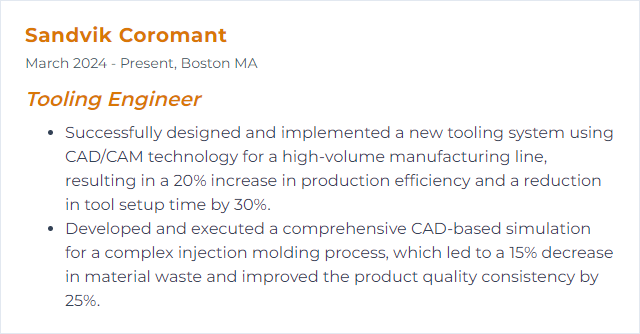
2. SolidWorks
SolidWorks is a CAD platform for building parametric 3D models, detailed drawings, and assemblies—ideal for molds, dies, and fixtures that must change and improve without blowing up the design.
Why It's Important
It accelerates tool design, simulation, and revision control. You validate form, fit, and function early and often, cut time-to-production, and reduce costly iterations.
How to Improve SolidWorks Skills
Own the fundamentals: Clean sketches, smart relations, robust features. Parametric discipline pays off when requirements shift.
Manage complex assemblies: Use mates, configurations, and lightweight techniques to keep performance snappy.
Use mold tooling features: Cavity/core, parting lines, shut-offs, draft checks—lean on the built-in tools to speed mold design.
Simulate early: Use simulation to probe deflection, stress, and thermal behavior before steel is cut.
Automate: Macros, design tables, and the API handle repetitive work and variants with less error.
Stay connected: User groups and forums surface tricks, pitfalls, and faster workflows you won’t find in menus.
How to Display SolidWorks Skills on Your Resume
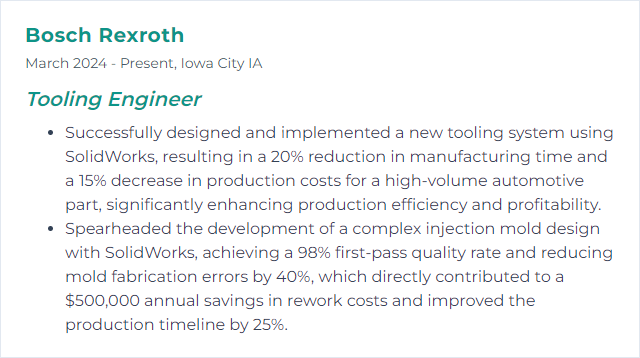
3. AutoCAD
AutoCAD is a CAD workhorse for precise 2D drawings and solid/mesh-based 3D models—handy for tooling layouts, detail drawings, and legacy interoperability.
Why It's Important
It delivers accuracy and clarity for prints, reference models, and shop documentation, ensuring tooling fits, functions, and gets released without confusion.
How to Improve AutoCAD Skills
Master core commands: Layers, blocks, xrefs, constraints, and fields—use them deliberately.
Tune tool palettes: Standardize symbols, notes, and details so drawings look consistent and get made faster.
Automate: Scripts, LISP routines, and custom commands eliminate tedious steps.
Use relevant add-ons: Add extensions that target mold/die workflows to speed repeatable tasks.
Practice 3D thoughtfully: When 3D is needed, keep models clean and manufacturable.
Track updates: New versions often bring productivity boosters—adopt what helps, ignore what doesn’t.
Learn from peers: Communities and forums save hours when you hit odd behaviors or gnarly files.
How to Display AutoCAD Skills on Your Resume
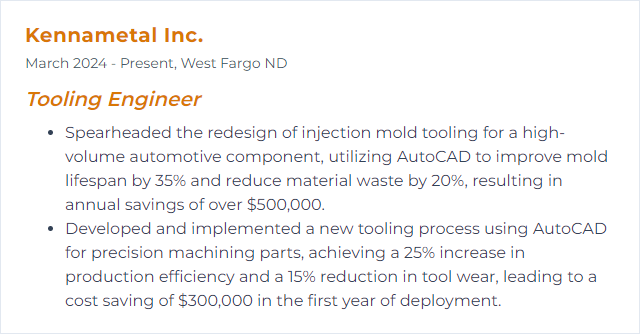
4. CNC Programming
CNC programming creates the code (often G-code) that drives machine tools. For tooling, it means translating intent into precise motion, feeds, speeds, and strategies that protect tooling, hit tolerances, and keep spindles cutting.
Why It's Important
Accuracy, repeatability, and efficiency ride on good code. The right toolpaths shrink cycle time, extend tool life, and prevent surprises on the machine.
How to Improve CNC Programming Skills
Invest in CAM mastery: Get fluent in your CAM platform—whether Mastercam, Fusion 360, SolidCAM, or others. Learn 3+2, simultaneous 5-axis, HEM, and rest machining.
Simulate everything: Verify for collisions, over-travel, and stock conditions before chips fly.
Optimize toolpaths: Choose strategies that balance material removal rate, surface finish, and tool wear.
Standardize code: Shared post-processors, naming, and documentation make programs readable and maintainable.
Tighten the feedback loop: Machinist input on chatter, chip control, and fixturing should feed revisions quickly.
Know your cutters: Tool geometry and coatings matter. Use vendors’ data and your own shop history to set feeds and speeds.
Automate the repetitive: Templates, ops libraries, and parametric setups reduce setup time and errors.
How to Display CNC Programming Skills on Your Resume
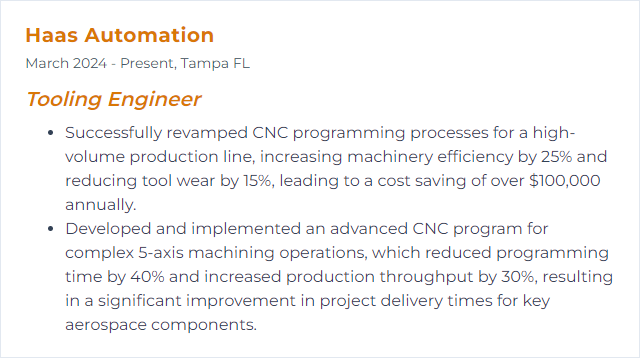
5. Injection Molding
Injection molding creates parts by pushing molten material into a mold, then cooling and ejecting. Tooling engineers design the mold architecture—gates, runners, cooling—so parts are consistent and cycles stay short.
Why It's Important
It enables high-volume, high-precision parts with tight tolerances. Good tooling decisions ripple into quality, yield, and cost per part.
How to Improve Injection Molding Skills
Design with data: Use simulation to tune gate location, runner sizing, packing, and cooling for balanced fill and minimal warpage.
Choose the right resin: Match mechanical, thermal, and chemical properties to the application and process window. Maintain accurate material cards.
Engineer the cooling: Conformal cooling, baffles, and smart circuits cut cycle time and stabilize dimensions.
Apply scientific molding: Set processes with pressure/temperature profiling and decoupled molding rather than tribal knowledge.
Maintain proactively: Standardize inspections, cleaning, and wear tracking. Predictive approaches prevent ugly downtime.
Keep learning: Advanced gating, venting, and specialty tooling (hot runners, valve gates) reward training.
How to Display Injection Molding Skills on Your Resume
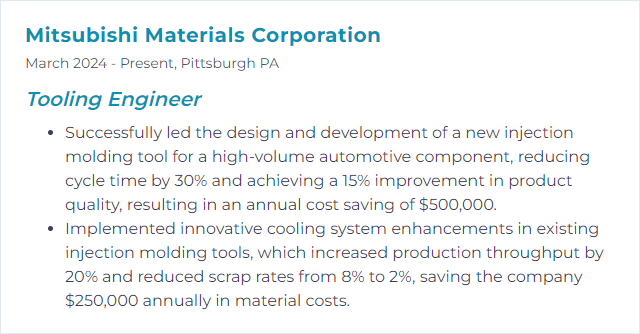
6. 3D Printing
3D printing builds parts layer by layer from digital models. For tooling, it speeds prototypes, fixtures, jigs, conformal-cooling inserts, and even bridge tooling with slashed lead times.
Why It's Important
Rapid iteration, complex geometry, and customization without new tooling. It unlocks designs that subtractive methods struggle to touch.
How to Improve 3D Printing Skills
Pick materials wisely: Weigh strength, heat deflection, chemical resistance, and wear. Match polymer, resin, or metal to the job.
Calibrate regularly: Level beds, tune nozzles, verify offsets, and run test coupons. Small drifts cause big headaches.
Tune slicing: Adjust layer height, wall counts, infill, supports, and acceleration for the right blend of strength, finish, and speed.
Design for AM: Orient parts for strength and surface quality; reduce supports; use lattices and internal channels where they help.
Mind post-processing: Deburr, bead blast, anneal, infiltrate, or machine critical faces as needed.
Validate dimensions: Measure consistently; update compensations and tolerances based on real prints.
How to Display 3D Printing Skills on Your Resume
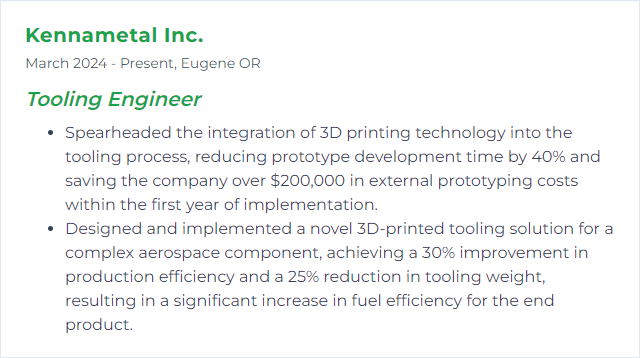
7. Pro/ENGINEER
Pro/ENGINEER, now known as PTC Creo, is a parametric 3D CAD suite with CAM and CAE tools. It’s well-suited for complex molds and dies that benefit from robust, feature-driven models.
Why It's Important
Integrated modeling, simulation, and manufacturing shorten the loop from concept to cut steel, raising precision while trimming cost.
How to Improve Pro/ENGINEER Skills
Train with intent: Focus on surfacing, top-down design, and change-friendly modeling practices for tooling.
Use specialized extensions: Mold analysis, mold base libraries, and expert frameworks accelerate real-world workflows.
Customize the environment: Tailored ribbons, mapkeys, start parts, and templates keep work fast and consistent.
Leverage simulation: Stress, thermal, and modal checks on plates, cores, and inserts prevent painful surprises.
Stay current: New releases often deliver quality-of-life improvements and performance gains worth adopting.
Learn from the community: Power users share gold—best practices, pitfalls, and clever parameter tricks.
How to Display Pro/ENGINEER Skills on Your Resume
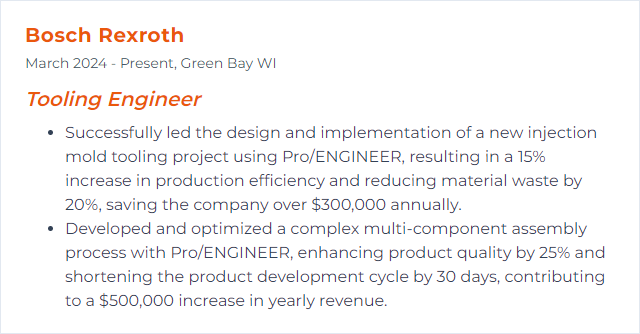
8. Moldflow
Moldflow simulates plastic injection molding, predicting fill, pack, cool, and warp behavior so you can shape the design before tooling is cut.
Why It's Important
It spots risks—short shots, weld lines, sink, warpage—early and guides design tweaks and process windows that save time and cash.
How to Improve Moldflow Skills
Mesh smart: Use the right element types and densities. Fine where it matters, coarse where it doesn’t.
Use accurate materials: Reliable viscosity, PVT, and shrink data drive credible results. Validate when in doubt.
Mirror the real process: Set realistic melt temps, mold temps, injection times, and packing pressures.
Engineer cooling: Model circuits and conformal paths carefully to stabilize parts and slash cycle time.
Interrogate warpage: Pair warpage results with design or process changes and iterate to convergence.
Collaborate: Share findings with design, processing, and quality so decisions stick.
Keep skills fresh: New solvers and features appear often—stay trained and experiment.
How to Display Moldflow Skills on Your Resume
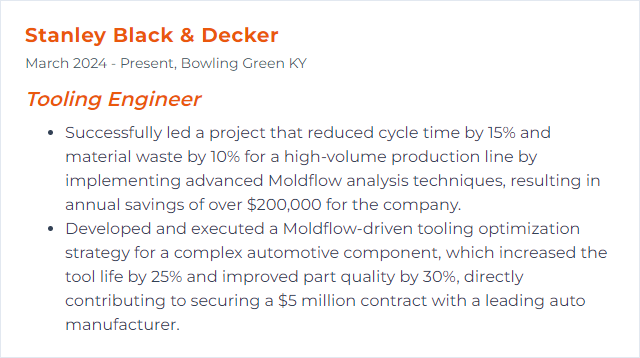
9. GD&T
GD&T (Geometric Dimensioning and Tolerancing) is the symbolic language that defines how features must exist in size, form, orientation, and location to function and assemble correctly. It clarifies design intent for manufacturing and inspection.
Why It's Important
It aligns teams. Parts interchange, inspections are unambiguous, and scrap drops because everyone reads the same map.
How to Improve GD&T Skills
Study the standard: Get comfortable with ASME Y14.5 concepts and how they apply to your parts.
Practice on real prints: Add datums, apply modifiers, and review tolerance stacks tied to function.
Use CAD correctly: Apply semantic GD&T where possible; keep callouts consistent and machine-readable.
Collaborate with QA: Align callouts with metrology capabilities and inspection plans.
Seek feedback: Peer reviews and mentor guidance expose blind spots quickly.
Iterate with intent: Tighten only what function demands; loosen where manufacturing needs breathing room.
How to Display GD&T Skills on Your Resume
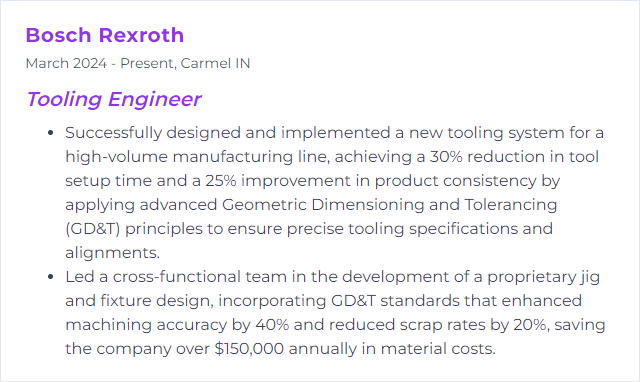
10. FEA
FEA (Finite Element Analysis) predicts how tools and fixtures respond to loads, heat, vibration, and contact. It shows stress, deflection, and risk before metal meets machine.
Why It's Important
It guides geometry, materials, and fasteners toward durability and performance—while avoiding overbuild and cost.
How to Improve FEA Skills
Model what matters: Capture real boundary conditions, contacts, and load paths. Simplify where you can, detail where you must.
Mesh with purpose: Refine in high-gradient regions; keep bulk coarse. Use appropriate elements for bending, contact, and thermal problems.
Use credible material data: Temperature-dependence, plasticity, and fatigue properties can make or break accuracy.
Validate: Correlate with tests or trusted benchmarks. Calibrate until predictions track reality.
Mind numerics: Pick solvers and settings suited to nonlinearity, contact, or transient heat.
Post-process clearly: Probe sections, paths, and safety factors; don’t rely on pretty pictures alone.
Keep learning: Advanced contact, submodeling, and optimization workflows pay dividends.
How to Display FEA Skills on Your Resume
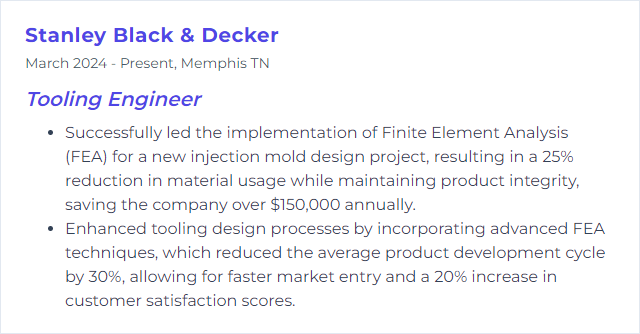
11. Mastercam
Mastercam is a CAM platform for programming CNC machines, simulating motion, and optimizing toolpaths for efficient, accurate tooling manufacture.
Why It's Important
It unlocks sophisticated strategies and automation that reduce cycle time, improve surface finish, and stabilize processes.
How to Improve Mastercam Skills
Start with structured training: Cover fundamentals, then move into multi-axis, mill-turn, and verification best practices.
Practice on real parts: Build ops libraries and templates from successful jobs.
Engage the community: Share files, compare strategies, and learn faster through peer examples.
Attend webinars and workshops: New features and toolpaths appear often—adopt the ones that pay off.
Earn certification: It formalizes skills and signals capability to employers.
Stay updated: Keep versions current and posts aligned with your machines.
Script and macroize: Automate repetitive programming steps and documentation.
Close the loop: Review results with machinists and QA, then refine toolpaths and parameters.
How to Display Mastercam Skills on Your Resume
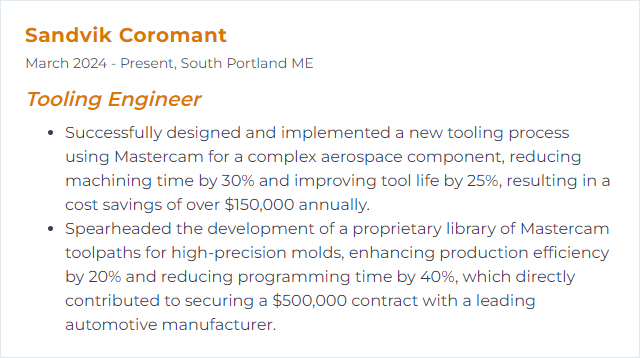
12. Lean Manufacturing
Lean Manufacturing streamlines processes to remove waste and elevate value. For tooling engineers, it means quicker changeovers, fewer defects, smarter maintenance, and designs that flow smoothly through production.
Why It's Important
Less downtime, lower cost, higher quality. Lean thinking keeps tools ready, processes stable, and teams aligned.
How to Improve Lean Manufacturing Skills
Run continuous improvement: Kaizen events aimed at setup reduction, scrap cuts, and flow improvements move the needle.
Implement 5S: Organize, label, clean, standardize, and sustain. Tooling and gages become easy to find and hard to lose.
Map the value stream: Visualize material and information flow. Remove bottlenecks, queues, and rework loops.
Standard work: Lock in best-known methods for setups, inspections, and maintenance.
Total Productive Maintenance: Plan preventive and predictive maintenance; involve operators to catch issues early.
Cross-train: Build a flexible workforce that can absorb demand swings and vacations without chaos.
Root-cause relentlessly: Use 5 Whys and fishbone analysis to fix causes, not symptoms.
Add cobots where it helps: Hand off repetitive or risky tasks to collaborative robots to boost safety and throughput.
Blend Lean with Six Sigma: Reduce variation while you remove waste to lift both quality and speed.
Adopt useful tech: MES, digital work instructions, and real-time dashboards make problems visible and solvable.
How to Display Lean Manufacturing Skills on Your Resume
